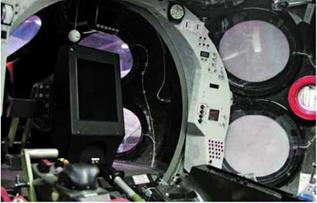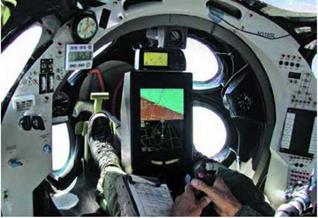Reaction Control System
Because there is no atmosphere in space, the flight control systems that ordinarily allow an aircraft to move through the air do not work for spacecraft moving through space. Rudders, elevators, and ailerons only work because air moves over them. With no air, they are useless.
In order to maneuver in space, spacecraft take advantage of a simple physics law discovered by Sir Isaac Newton:for every action, there is an equal and opposite reaction.
Without considering a spacesuit, for example, if a person was in space and blew through a straw, the air would move out the straw in one direction and the person would move in the opposite direction.
Figure 6.8 shows an astronaut with a hand-held reaction control system (RCS). To move, he just points the opposite direction, releases a puff of gas, and off he goes in the direction he wants. This, by the way, is the same principle by which a rocket engine works. The RCS thrusters are just miniature rocket engines.
 ( ■ >1 Fig. 6.8. In Gemini 4, astronaut Ed White made the first U. S.
( ■ >1 Fig. 6.8. In Gemini 4, astronaut Ed White made the first U. S.
spacewalk. To maneuver during his 23-minute extravehicular activity
(EVA), he used a hand-held self maneuvering unit (HHSMU) that shot
little bursts of gas, which allowed him to move around. This device
worked similar to the way SpaceShipOne’s reaction control system works.
NASA-Johnson Space Center
к_________________________ J
The Space Shuttle uses a fuel of monomethylhydrazine (MMH) and an oxidizer of nitrogen tetroxide (N204) for its RCS. These propellants react together spontaneously once in contact. As long as each chemical is stored safely separate, they provide the orbiter a simple, reliable, precise, and powerful RCS.
SpaceShipOne had limited time in space and was much less massive than the Space Shuttle. The force generated by these expensive and toxic chemicals was not required. So, puffs of air were sufficient to maneuver SpaceShipOne in space.
After the aerodynamic control authority was gone, the pilot used the RCS to help slow down or null any rotation that had developed while exiting the atmosphere. Each wingtip had roll thrusters, and along the top, bottom, and sides of the fuselage were pitch and yaw thrusters. Each of these thrusters was essentially a port from which high-pressure air could be expelled, and each thruster had a backup. Redundant 6,000-psi bottles of air powered the RCS. By fully extending the rudder petals and the control stick, the pilot maneuvered SpaceShipOne by triggering microswitches that turned the appropriate thrusters either full-on or full-off.
The RCS was also used to get into position for reentry. Scaled Composites had confidence that the feather would self-right SpaceShipOne. However, they did not want to start off upside-down if they didn’t have to.
Tier One Navigation Unit
The pilot had to fly a specific trajectory carefully during a mission. If he deviated, he risked not only failing to reach the target altitude but also missing the prescribed reentry area or, in the extreme case, being too far away from the landing site.
“The aircraft itself was completely manually controlled,” Pete Siebold said. “So, the only feedback the pilot had to how the airplane was flying was through the avionics system.”
It was necessary to develop an avionics system, called the Tier One navigation unit (TONU), for SpaceShipOne. “There really was nothing available within our budget and nothing available off the shelf that suited our needs. So, we had to go develop it ourselves,” Siebold said. The system navigation unit (SNU) and the flight director display (FDD) were the two primary components that made up the TONU.
“We had contracted a company to basically develop the hardware portion of the nav system,” Siebold said. “They built the boxes and put the computers in. They were initially responsible for developing the software of the navigation system as well. However, we ended up making major modifications to that software at the end of the program to make it perform the way we needed it to perform. On the display side, we wrote all the software for the entire program from the beginning.” Aside from being a test pilot, Siebold was the engineer behind most of the software design. Fundamental Technology Systems (FTS), also an Ansari X Prize competitor, provided the hardware and initial software to Scaled Composites.
Acting as the brain of the TONU, the SNU incorporated both a global positioning system (GPS) and an inertial navigation system (INS). It sent guidance and navigational information to the pilot, who saw it on the liquid crystal display (LCD) screen of the FDD in glass- cockpit-type fashion. The SNU navigates along the primary flight axes in six degrees of freedom: the translations of left/right, forward/back, and up/down and the rotations of yaw, roll, and pitch.
Close-ups of the FDD are shown in figure 6.9 and figure 6.10, which also show the similarity between the cockpits of SpaceShipOne and White Knight.
Fly-by-wire was not an option. Siebold said, “It wasn’t warranted for the complexity of this program. Fly-by-wire adds a whole order of magnitude to the whole vehicle development costs. And we really wanted to keep this as simple as possible in order to make this affordable for everybody. That is really the backbone of this program. If you can make it as simple as a Volkswagen, then everybody can afford it. If it needs to be as complex as the Space Shuttle, then nobody can afford it. We really had to push really hard toward making it affordable from the onset.”
The data available to the pilot is based on several modes that correspond to the different phases of flight for SpaceShipOne. Figures 6.11 to 6.14 show various FDD modes, including a boost, a reentry, and a glide. In these modes, the pilot is given trajectory guidance with respect to a detailed map that tracks the position of SpaceShipOne. The FDD automatically stepped through the different modes while flying the mission, but a control allowed the pilot to manually move through the modes in the unlikely event he needed to do so.
Siebold said, “We had the initial boost portion. So, that was the pull up. Then it transitioned to a pseudo-boost mode were everything zoomed in and allowed you to track your final target, fly that
|
|
г ; л
Fig. 6.9. A close-up of the flight director display (FDD) for SpaceShipOne is shown in this photograph. The FDD was part of the Tier One navigation unit (TONU) and provided the test pilot with instruments similar to the way a glass cockpit does for an airliner.
Mojave Aerospace Ventures LLC, photograph by David M. Moore
V_____________________________________ J apple onto your target. Once the motor shut down, it transitioned to a coast phase. Once you left the atmosphere, it transitioned into a reentry phase. Once you reentered, it transitioned into three different glide phases. We called them high key, final, and landing phase. And those three phases helped you to find your way back to the airport, and manage your energy so that you’d end up touching down at the place you wanted.”
Sometimes SpaceShipOne nearly pointed straight up, and sometimes it was upside-down. The attitude, or orientation, of SpaceShipOne in flight was key flight information provided on the FDD. “It showed you whether or not you are at wings level,” Siebold explained. “One unique aspect of the display was that as you pitched the nose up, when the horizon on the display disappeared, it still gave you situational feedback to tell you what attitude the aircraft was in.”
A second key piece of flight information was the velocity vector. “What that tells you,” Siebold said, “is the direction in which you are currently flying—the direction in which your velocity is currently heading. That was depicted on the screen with what we called the green apple. It was a green circle with a tail and two wings pointing out of it.” So, with the pilot knowing how SpaceShipOne was oriented and how it was moving in flight, the FDD offered two other bits of crucial flight information. These were the location of the optimum trajectory, represented by the “red donut,” and where SpaceShipOne was with respect to it, which was the “green apple.”
In a presentation at NASA Ames, Doug Shane had given the following succinct description: “The goal is to take that green velocity vector and put it right over that red donut, because that is the flight-director cue. And that gets you to the reentry point that you want. Very simplemindedly, your task is only to get those two circles closed up as quickly as you can. And that establishes essentially a vertical trajectory and gives you the best performance that you can get.”
In addition, the SNU monitored and recorded how the systems of SpaceShipOne were performing and fed this information to the FDD, where it was displayed. “It acted as a caution/warning/advisory system,” Siebold said. “It told you if there is any parameter out of limits, or if
|
|
Ґ ^
Fig. 6.10. The inside of White Knight’s cockpit, shown here, is remarkably similar to the cockpit of SpaceShipOne. Even the instrumentation and controls are nearly identical, with the obvious exception that SpaceShipOne has rocket-engine controls and White Knight has jet-engine controls. Since White Knight started flying about a year before SpaceShipOne, this allowed Scaled Composites to build up confidence in the instruments prior to flying SpaceShipOne. Also, White Knight could be used as a trainer for SpaceShipOne. Mojave Aerospace Ventures LLC, photograph by Scaled Composites
v___________________ J
there is anything out of limits that would cause you to abort the flight. We had a small list of parameters that if they ever exceeded some allowable range, they’d flash a big red sign that said ‘abort.’”
During the rocket engine burn, things happened fast. There was not a lot of time to make decisions. The TONU did not automatically control SpaceShipOne. “The pilot still had to look at the information, digest it, and make the appropriate decision with that information,” Siebold said.
Data that the SNU collected then displayed to the pilot on the FDD was also transmitted real-time to Mission Control on the ground by a radio frequency (RF) telemetry downlink. In Mission Control, the data reduction system (DRS) collected, processed, and stored all the transmitted data and made it accessible to everyone in Mission Control.












